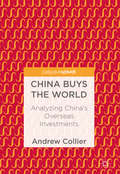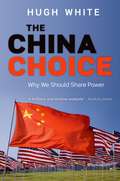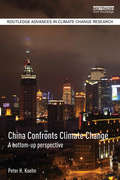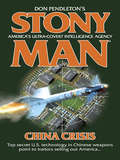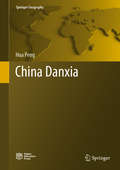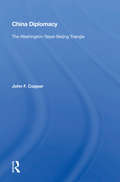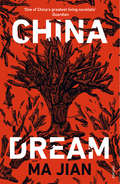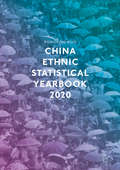- Table View
- List View
China, Britain and Businessmen: Political and Commercial Relations, 1949–57 (St Antony's Series)
by Wen-guang ShaoIn the author's opinion, commercial relations between China and Britain in the 1950s determined subsequent economic relations between the countries more than is commonly recognized. This book examines how trade was effected by the revolution and the crises surrounding the Korean war.
China Buys the World: Analyzing China's Overseas Investments
by Andrew CollierThis book discusses the strategies that will define China’s overseas expansion in the coming years. China is spending billions of dollars acquiring overseas companies and assets, from the Chicago Mercantile Exchange to the Hinkley Point nuclear station. Will this corporate buying binge continue? In this book, Collier argues that state control will occur only among certain strategically key acquisitions while many of the corporate acquisitions will be done by smaller, private firms. However, China’s rising debt load may restrict the ability of many firms to obtain capital, including from China’s shadow banking sector. A key to understanding China’s strategy is to look at how the state intervenes in private business. Collier ably brings clarity to the “gray area” between state and private economic activity in this complex landscape. As the West faces China’s growing investments abroad, this book will be required reading for executives and decision makers, journalists, and policy makers.
China Buys the World: Analyzing China's Overseas Investments
by Andrew CollierThis book discusses the strategies that will define China’s overseas expansion in the coming years. China is spending billions of dollars acquiring overseas companies and assets, from the Chicago Mercantile Exchange to the Hinkley Point nuclear station. Will this corporate buying binge continue? In this book, Collier argues that state control will occur only among certain strategically key acquisitions while many of the corporate acquisitions will be done by smaller, private firms. However, China’s rising debt load may restrict the ability of many firms to obtain capital, including from China’s shadow banking sector. A key to understanding China’s strategy is to look at how the state intervenes in private business. Collier ably brings clarity to the “gray area” between state and private economic activity in this complex landscape. As the West faces China’s growing investments abroad, this book will be required reading for executives and decision makers, journalists, and policy makers.
China Confronts Climate Change: A bottom-up perspective (Routledge Advances in Climate Change Research)
by Peter H. KoehnChina is an integral actor in any movement that will stabilize the global climate at conditions suited to sustainable development for its own population and for people living around the world. Assessments of China’s climatic-system consequences, impact, and responsibilities need to take into account the strengths, weaknesses, and potential of subnational governments, non-governmental organizations, transnational non-state connections, and the urban populace in reducing greenhouse-gas emissions. A multitude of recent local initiatives that have engaged subnational China in actions that mitigate emissions can be enhanced by powerful framings that appeal to citizen concerns about air pollution and health conditions. China Confronts Climate Change offers the first fully comprehensive account of China’s response to climate change, based on engagement with the global climate governance literature and current debates over responsibility along with specific insights into the Chinese context. Responsible implementation of any overarching climate agreement depends on expanding China’s subnational contributions. To remain fully informed about GHG-emissions mitigation, China watchers and climate-change monitors need to pay close attention to bottom-up developments. The book provides a valuable contemporary resource for students, scholars, and policy leaders at all levels of governance who are concerned with climate change, environmental politics, and sustainable urban development.
China Confronts Climate Change: A bottom-up perspective (Routledge Advances in Climate Change Research)
by Peter H. KoehnChina is an integral actor in any movement that will stabilize the global climate at conditions suited to sustainable development for its own population and for people living around the world. Assessments of China’s climatic-system consequences, impact, and responsibilities need to take into account the strengths, weaknesses, and potential of subnational governments, non-governmental organizations, transnational non-state connections, and the urban populace in reducing greenhouse-gas emissions. A multitude of recent local initiatives that have engaged subnational China in actions that mitigate emissions can be enhanced by powerful framings that appeal to citizen concerns about air pollution and health conditions. China Confronts Climate Change offers the first fully comprehensive account of China’s response to climate change, based on engagement with the global climate governance literature and current debates over responsibility along with specific insights into the Chinese context. Responsible implementation of any overarching climate agreement depends on expanding China’s subnational contributions. To remain fully informed about GHG-emissions mitigation, China watchers and climate-change monitors need to pay close attention to bottom-up developments. The book provides a valuable contemporary resource for students, scholars, and policy leaders at all levels of governance who are concerned with climate change, environmental politics, and sustainable urban development.
China Constructing Capitalism: Economic Life and Urban Change (International Library of Sociology)
by Michael Keith Scott Lash Jakob Arnoldi Tyler RookerChina has been growing at over ten per cent annually since 1978, but this has only come to very widespread notice in the past decade. This received wisdom about China has been largely of two types, both of which – more or less – understand China in the context of neoliberalism. The more business- or business studies-oriented literature seems to argue that if China does not adapt the rule of clear and distinct property and contract law – in short, of Western institutions – its economy will stall. The second set of voices is more clearly from the left, arguing that the Chinese economy, and city, is neo-liberal. For them, China does not diverge widely from the Anglo-American model that, from 2008, has brought the world economy to its knees. China Constructing Capitalism takes issue with these analyses. The authors argue that it is not Western neo-liberalism that is constructing the Chinese economy, but instead that China is constructing its own version of capitalism. The two central theses of their argument are: economic life – neo-liberal economic life is individualized and disembedded, while the China model is relational and situated urban change – China has created a form of ‘local state capitalism’ which stands in contrast to neoliberal versions of the city. This book analyses China as a 'risk culture', examining among others Chinese firms and political ties, property development, migrant urbanisms and share trading rooms. It scrutinises the ever-present shadow of the risk-averse (yet uncertainty-creating) state. China Constructing Capitalism is a must-read for social scientists, policy makers and investors.
China Constructing Capitalism: Economic Life and Urban Change (International Library of Sociology)
by Michael Keith Scott Lash Jakob Arnoldi Tyler RookerChina has been growing at over ten per cent annually since 1978, but this has only come to very widespread notice in the past decade. This received wisdom about China has been largely of two types, both of which – more or less – understand China in the context of neoliberalism. The more business- or business studies-oriented literature seems to argue that if China does not adapt the rule of clear and distinct property and contract law – in short, of Western institutions – its economy will stall. The second set of voices is more clearly from the left, arguing that the Chinese economy, and city, is neo-liberal. For them, China does not diverge widely from the Anglo-American model that, from 2008, has brought the world economy to its knees. China Constructing Capitalism takes issue with these analyses. The authors argue that it is not Western neo-liberalism that is constructing the Chinese economy, but instead that China is constructing its own version of capitalism. The two central theses of their argument are: economic life – neo-liberal economic life is individualized and disembedded, while the China model is relational and situated urban change – China has created a form of ‘local state capitalism’ which stands in contrast to neoliberal versions of the city. This book analyses China as a 'risk culture', examining among others Chinese firms and political ties, property development, migrant urbanisms and share trading rooms. It scrutinises the ever-present shadow of the risk-averse (yet uncertainty-creating) state. China Constructing Capitalism is a must-read for social scientists, policy makers and investors.
China Crisis
by Don PendletonWhen talks and negotiations stall, when rampant violence goes unchecked, the covert arm of the U.S. Justice Department enters the fray at Presidential command.
China Danxia (Springer Geography)
by Hua PengThis book presents the major research advances relating to Chinese Danxia landforms over the past 80 years. It covers geological setting, morphologic characteristics and evolution, biology and ecology, aesthetic value and earth science value, and briefly introduces the six heritage sites, enabling readers to gain a systematic understanding of Danxia landform theories and the China Danxia World Heritage sites.
The China Development Model: Between the State and the Market
by Dominique de RamburesOver the last thirty years, China has been reforming its economy at breakneck speed. However a surge in nationalism is threatening China's relations with its neighbours and its rise to regional leadership. This book addresses a wide range of factors influencing the development of China's model and its influence on the rest of the world.
The China Diary of George H. W. Bush: The Making of a Global President
by Jeffrey A. Engel George H. BushAvailable in print for the first time, this day-by-day diary of George H. W. Bush's life in China opens a fascinating window into one of the most formative periods of his career. As head of the United States Liaison Office in Beijing from 1974 to 1975, Bush witnessed high-level policy deliberations and daily social interactions between the two Cold War superpowers. The China Diary of George H. W. Bush offers an intimate look at this fundamental period of international history, marks a monumental contribution to our understanding of U.S.-China relations, and sheds light on the ideals of a global president in the making. In compelling words, Bush reveals a thoughtful and pragmatic realism that would guide him for decades to come. He considers the crisis of Vietnam, the difficulties of détente, and tensions in the Middle East, while lamenting the global decline in American power. He formulates views on the importance of international alliances and personal diplomacy, as he struggles to form meaningful relationships with China's top leaders. With a critical eye for detail, he depicts key political figures, including Gerald Ford, Donald Rumsfeld, Deng Xiaoping, and the ever-difficult Henry Kissinger. Throughout, Bush offers impressions of China and its people, describing his explorations of Beijing by bicycle, and his experiences with Chinese food, language lessons, and Ping-Pong. Complete with a preface by George H. W. Bush, and an introduction and essay by Jeffrey Engel that place Bush's China experience in the broad context of his public career, The China Diary of George H. W. Bush offers an unmediated perspective on American diplomatic history, and explores a crucial period's impact on a future commander in chief.
The China Diary of George H. W. Bush: The Making of a Global President
by Jeffrey A. Engel George H. BushAvailable in print for the first time, this day-by-day diary of George H. W. Bush's life in China opens a fascinating window into one of the most formative periods of his career. As head of the United States Liaison Office in Beijing from 1974 to 1975, Bush witnessed high-level policy deliberations and daily social interactions between the two Cold War superpowers. The China Diary of George H. W. Bush offers an intimate look at this fundamental period of international history, marks a monumental contribution to our understanding of U.S.-China relations, and sheds light on the ideals of a global president in the making. In compelling words, Bush reveals a thoughtful and pragmatic realism that would guide him for decades to come. He considers the crisis of Vietnam, the difficulties of détente, and tensions in the Middle East, while lamenting the global decline in American power. He formulates views on the importance of international alliances and personal diplomacy, as he struggles to form meaningful relationships with China's top leaders. With a critical eye for detail, he depicts key political figures, including Gerald Ford, Donald Rumsfeld, Deng Xiaoping, and the ever-difficult Henry Kissinger. Throughout, Bush offers impressions of China and its people, describing his explorations of Beijing by bicycle, and his experiences with Chinese food, language lessons, and Ping-Pong. Complete with a preface by George H. W. Bush, and an introduction and essay by Jeffrey Engel that place Bush's China experience in the broad context of his public career, The China Diary of George H. W. Bush offers an unmediated perspective on American diplomatic history, and explores a crucial period's impact on a future commander in chief.
China Diplomacy: The Washington-Taipei-Beijing Triangle
by John F. CopperThis book, examining the process that created the Taiwan Relations Act (TRA), endeavors to assess the TRA in terms of its role in guiding or determining U.S. China policy, in preserving the sovereignty of Taiwan, in promoting democracy there, and in resolving the "Taiwan issue."
China Diplomacy: The Washington-Taipei-Beijing Triangle
by John F. CopperThis book, examining the process that created the Taiwan Relations Act (TRA), endeavors to assess the TRA in terms of its role in guiding or determining U.S. China policy, in preserving the sovereignty of Taiwan, in promoting democracy there, and in resolving the "Taiwan issue."
China Dream
by Ma JianA poetic and unflinching fable about tyranny, guilt, and the erasure of history, by the banned Chinese writer hailed as ‘China’s Solzhenitsyn’.In seven dream-like episodes, Ma Jian charts the psychological disintegration of a Chinese provincial leader who is haunted by nightmares of his violent past. From exile, Ma Jian shoots an arrow at President Xi Jinping’s ‘China Dream’ propaganda, creating a biting satire of totalitarianism that reveals what happens to a nation when it is blinded by materialism and governed by violence and lies. Blending tragic and absurd reality with myth and fantasy, this dystopian novel is a portrait not of an imagined future, but of China today.PRAISE FOR MA JIAN'S WORK‘A landmark work of fiction’ Daily Telegraph‘Worthy of Swift or Orwell’ Observer‘A modern literary masterpiece’ Sunday Express‘Monumental . . . Riveting . . . A mighty gesture of remembrance against the encroaching forces of silence’ Guardian‘A born storyteller who has the artistry and intellect to evoke a staggeringly large and densely peopled world. His language is precise and sublimely visual; it is painfully funny’ Madeleine Thien‘In scene after scene of black satire, lyric tenderness and desolating tragedy . . . this fearless epic of history and memory establishes Ma Jian as the Solzhenitsyn of China’s forgetful drive towards world domination’ Independent‘Ma Jian has accomplished something extremely difficult. That is, he has created a work of art that functions simultaneously as literature and call to action’ New York Review of Books
China Dreams: 20 Visions of the Future
by William A. CallahanAfter celebrating their country's three decades of fantastic economic success, many Chinese are now asking, "What comes next?" How can China convert its growing economic power into political and cultural influence around the globe? William A. Callahan's China Dreams gives voice to China's many different futures by exploring the grand aspirations and deep anxieties of a broad group of public intellectuals. Stepping outside the narrow politics of officials vs. dissidents, Callahan examines what a third group--"citizen intellectuals"--think about China's future. China Dreams eavesdrops on fascinating conversations between officials, scholars, soldiers, bloggers, novelists, film-makers and artists to see how they describe China's different political, strategic, economic, social and cultural futures. Callahan also examines how the PRC's new generation of twenty- and thirty-somethings is creatively questioning "The China Model" of economic development. The personal stories of these citizen intellectuals illustrate China's zeitgeist and a complicated mix of hopes and fears about "The Chinese Century," providing a clearer sense of how the PRC's dramatic economic and cultural transitions will affect the rest of the world. China Dreams explores the transnational connections between American and Chinese people, providing a new approach to Sino-American relations. While many assume that 21st century global politics will be a battle of Confucian China vs. the democratic west, Callahan weaves Chinese and American ideals together to describe a new "Chimerican dream."
China Dreams: 20 Visions of the Future
by William A. CallahanAfter celebrating their country's three decades of fantastic economic success, many Chinese are now asking, "What comes next?" How can China convert its growing economic power into political and cultural influence around the globe? William A. Callahan's China Dreams gives voice to China's many different futures by exploring the grand aspirations and deep anxieties of a broad group of public intellectuals. Stepping outside the narrow politics of officials vs. dissidents, Callahan examines what a third group--"citizen intellectuals"--think about China's future. China Dreams eavesdrops on fascinating conversations between officials, scholars, soldiers, bloggers, novelists, film-makers and artists to see how they describe China's different political, strategic, economic, social and cultural futures. Callahan also examines how the PRC's new generation of twenty- and thirty-somethings is creatively questioning "The China Model" of economic development. The personal stories of these citizen intellectuals illustrate China's zeitgeist and a complicated mix of hopes and fears about "The Chinese Century," providing a clearer sense of how the PRC's dramatic economic and cultural transitions will affect the rest of the world. China Dreams explores the transnational connections between American and Chinese people, providing a new approach to Sino-American relations. While many assume that 21st century global politics will be a battle of Confucian China vs. the democratic west, Callahan weaves Chinese and American ideals together to describe a new "Chimerican dream."
China Engages Global Health Governance: Responsible Stakeholder or System-Transformer? (Palgrave Series in Asian Governance)
by L. ChanThis book explores public health in China in particular the management of the HIV/AIDS epidemic, with the goal of understanding China's compliance with and resistance to the norms and rules embedded in the global health regime.
China Engages Latin America: Distorting Development and Democracy?
by R. Evan EllisThis book explores China’s engagement with Latin America and the Caribbean as a case study of its broader effort to use commercial tools and instruments of state to create a global economic order that functions to its benefit, while neutralizing challenges from institutions, states, and others that would oppose it. Unlike the common representation of the Cold War as a political-military struggle, this work uniquely examines China’s current efforts as primarily seeking to dominate global value chains, with supporting political, technological, and military components. In this regard, it both leverages and goes beyond works based on dependency theory, which has played a key role in the academic and popular discourse in the region.The book examines evidence for China’s economically-focused strategy within Latin America and the Caribbean, including the interrelationships and coordination between China’s activities in different sectors, and between commercial, political, and other dimensions in the region. It further looks at the supporting role played by a diverse range of Chinese initiatives, from China’s Belt and Road initiative, to people-to-people diplomacy, soft power, security engagement, and the PRC struggle with Taiwan for diplomatic recognition in the region, among others. The book highlights the implications for Latin America and the Caribbean, and for the U.S. whose prosperity and security is intimately tied to the region.
China Ethnic Statistical Yearbook 2016
by Rongxing GuoThis book, comprised of entirely original research, collects data on the socioeconomic situation of China’s 56 ethnic groups. Although the majority of China’s population is of the Han nationality (which accounts for more than 90% of China’s population), the non-Han ethnic groups have a population of more than 100 million. China has officially identified, except for other unknown ethnic groups and foreigners with Chinese citizenship, 55 ethnic minorities. In addition, ethnic minorities vary greatly in size. With a population of more than 15 million, the Zhuang are the largest ethnic minority, and the Lhoba, with a population of only about three thousand, the smallest. China’s ethnic diversity has resulted in a special socioeconomic landscape for China itself. However, till presently, a complete socioeconomic picture of China’s ethnic groups – especially of its smallest ethnic minorities – still remained unclear. How different have China’s ethnic groups been in every sphere of daily life and economic development during China’s fast transition period? In order to answer these questions, we have created a detailed and comparable set of data for each of China’s ethnic groups. This book presents, in an easy-to-use format, a broad collection of social and economic indicators on China’s 56 ethnic groups. This useful resource profiles the general social and economic situations for each of these ethnic groups. These indicators are compiled and estimated based on the regional and local data gathered from a variety of sources up to 2012.
China Ethnic Statistical Yearbook 2016
by Rongxing GuoThis book, comprised of entirely original research, collects data on the socioeconomic situation of China’s 56 ethnic groups. Although the majority of China’s population is of the Han nationality (which accounts for more than 90% of China’s population), the non-Han ethnic groups have a population of more than 100 million. China has officially identified, except for other unknown ethnic groups and foreigners with Chinese citizenship, 55 ethnic minorities. In addition, ethnic minorities vary greatly in size. With a population of more than 15 million, the Zhuang are the largest ethnic minority, and the Lhoba, with a population of only about three thousand, the smallest. China’s ethnic diversity has resulted in a special socioeconomic landscape for China itself. However, till presently, a complete socioeconomic picture of China’s ethnic groups – especially of its smallest ethnic minorities – still remained unclear. How different have China’s ethnic groups been in every sphere of daily life and economic development during China’s fast transition period? In order to answer these questions, we have created a detailed and comparable set of data for each of China’s ethnic groups. This book presents, in an easy-to-use format, a broad collection of social and economic indicators on China’s 56 ethnic groups. This useful resource profiles the general social and economic situations for each of these ethnic groups. These indicators are compiled and estimated based on the regional and local data gathered from a variety of sources up to 2012.
China Ethnic Statistical Yearbook 2020
by Rongxing GuoThis fully updated edition of the China Ethnic Statistic Yearbook, comprised of entirely original research, presents data on the socioeconomic situation of China’s 56 ethnic groups. Although the majority of China’s population is of the Han nationality (which accounts for more than 90% of China’s population), the non-Han ethnic groups have a population of more than 100 million. China has officially identified, except for other unknown ethnic groups and foreigners with Chinese citizenship, 55 ethnic minorities. In addition, ethnic minorities vary greatly in size. With a population of more than 15 million, the Zhuang are the largest ethnic minority, and the Lhoba, with a population of only about three thousand, the smallest. China’s ethnic diversity has resulted in a special socioeconomic landscape for China itself. How different have China’s ethnic groups been in every sphere of daily life and economic development during China’s fast transition period? In order to answer these questions, we have created a detailed and comparable set of data for each of China’s ethnic groups. This book presents, in an easy-to-use format, a broad collection of social and economic indicators on China’s 56 ethnic groups. This useful resource profiles the general social and economic situations for each of these ethnic groups. These indicators are compiled and estimated based on the regional and local data gathered from a variety of sources up to 2016 with up to date analysis. This Yearbook also includes a new chapter on China’s spatial (dis)integration as a multiethnic paradox.
China-EU Relations: Reassessing the China-EU Comprehensive Strategic Partnership (Research Series on the Chinese Dream and China’s Development Path)
by Hong ZhouThis book provides a comprehensive review of relations between China and the EU from the perspectives of politics, economy and culture in order to provide a better understanding of the development of the China-EU Strategic Partnership over the past ten years and to explore its future direction. It goes on to discuss China-EU relations against the backdrop of global governance, as well as China’s relations with some of the EU member states. The final part of the report presents a comparative analysis of China-EU relations and EU-US relations. This book will help readers to better understand the status quo and to predict China-EU relations in the near future.
China-EU Relations in a New Era of Global Transformation (New Regionalisms Series)
by Li XingThis book draws together leading experts to examine the key issues in China-EU relations. China-EU relations are increasingly complex and affected by a number of inter-related factors, such as China’s global rise, growing China-US strategic competition, US global withdrawal, the transatlantic split, the China-Russia comprehensive "alliance," and Brexit. The book highlights the struggles of both China and the EU to look for a dynamic and durable mode of engagement in an attempt to achieve the balance between opportunities and challenges, and between partnership and rivalry. International contributors explore how to conceptualise China-EU relations and identify their differences and commonalities such as the EU’s role in China’s foreign policy process and how the EU works with China as a strategic partner. Finally, it analyses China’s and the EU’s perceptions of their own present and future roles. Shedding light on the perspectives of understanding and change in China-EU relations and its impact on multilateralism, it will appeal to researchers and professionals working in International Relations, International Political Economy and area studies who are interested in the rise of emerging powers and the changing world order.

